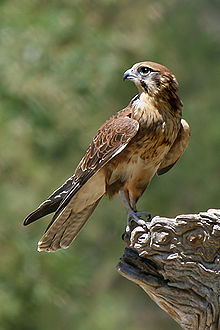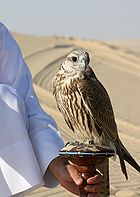
Falcon
About this schools Wikipedia selection
SOS Children, which runs nearly 200 sos schools in the developing world, organised this selection. Do you want to know about sponsoring? See www.sponsorachild.org.uk
| Falcon | |
|---|---|
 |
|
| Brown Falcon (Falco berigora) | |
| Scientific classification | |
| Kingdom: | Animalia |
| Phylum: | Chordata |
| Class: | Aves |
| Order: | Falconiformes |
| Family: | Falconidae |
| Subfamily: | Falconinae |
| Genus: | Falco Linnaeus, 1758 |
| Species | |
|
About 37; see text. |
|
| Synonyms | |
|
|
A falcon (pronounced /ˈfɔːlkən/ or /ˈfælkən/) is any species of raptor in the genus Falco. The genus contains 37 species, widely distributed throughout Europe, Asia, and North America.
Adult falcons have thin tapered wings, which enable them to fly at high speed and to change direction rapidly. Fledgling falcons, in their first year of flying, have longer flight feathers which makes their configuration more like that of a general-purpose bird such as a broadwing. This makes it easier to fly while learning the exceptional skills required to be effective hunters as adults.
Peregrine Falcons have been recorded diving at speeds of 200 miles per hour (320 km/h), making them the fastest-moving creatures on Earth. Other falcons include the Gyrfalcon, Lanner Falcon, and the Merlin. Some small falcons with long narrow wings are called hobbies, and some which hover while hunting are called kestrels. The falcons are part of the family Falconidae, which also includes the caracaras, Laughing Falcon, forest falcons, and falconets.
The traditional term for a male falcon is tercel ( British spelling) or tiercel (American spelling), from Latin tertius = third because of the belief that only one in three eggs hatched a male bird. Some sources give the etymology as deriving from the fact that a male falcon is approximately one third smaller than the female ( Old French tiercelet).
A falcon chick, especially one reared for falconry, that is still in its downy stage is known as an eyas (sometimes spelt eyass). The word arose by mistaken division of Old French un niais, from Latin presumed nidiscus ("nestling", from nidus = nest). The technique of hunting with trained captive birds of prey is known as falconry.
As is the case with many birds of prey, falcons have exceptional powers of vision; one species has a visual acuity of 2.6 times that of a normal human.
In February 2005, the Canadian ornithologist Louis Lefebvre announced a method of measuring avian intelligence in terms of a bird's innovation in feeding habits. The falcon and corvids scored highest on this scale.
Systematics and evolution
Compared to other birds of prey, the fossil record of the falcons is not well distributed in time. The oldest fossils tentatively assigned to this genus are from the Late Miocene, less than 10 million years ago. This coincides with a period in which many modern genera of birds became recognizable in the fossil record. The falcon lineage may however be somewhat older than this and given the distribution of fossil and living Falco taxa is probably of North American, African or possibly Middle Eastern or European in origin.
Falcons are roughly divisible into three or four groups. The first contains the kestrels (probably excepting the American Kestrel); usually small and stocky falcons of mainly brown upperside colour and sometimes sexually dimorphic; three African species that are generally grey in colour stand apart from the typical members of this group. Kestrels feed chiefly on terrestrial vertebrates and invertebrates of appropriate size, such as rodents, reptiles, or insects.
The second group contains slightly larger (on average) and more elegant species, the hobbies and relatives. These birds are characterized by considerable amounts of dark slate-grey in their plumage; the malar area is nearly always black. They feed mainly on smaller birds.
Third are the Peregrine Falcon and its relatives: large powerful birds which also have a black malar area (except some very light colour morphs), and often a black cap also. Otherwise, they are somewhat intermediate between the other groups, being chiefly medium grey with some lighter or brownish colours on the upper side. They are on average more delicately patterned than the hobbies and if the hierofalcons are excluded (see below), this group contains typically species with horizontal barring on the underside. As opposed to the other groups, where tail colour varies much in general but little according to evolutionary relatedness, the tails of the large falcons are quite uniformly dark grey with rather inconspicuous black banding and small white tips, though this is probably plesiomorphic. These large Falco feed on mid-sized birds and terrestrial vertebrates.
Very similar to these and sometimes included therein are the 4 or so species of hierofalcons (literally, "hawk-falcons"). They represent taxa with usually more phaeomelanins which impart reddish or brown colours, and generally more strongly patterned plumage reminiscent of hawks. Notably, their undersides have a lengthwise pattern of blotches, lines or arrowhead marks. While these three or four groups, loosely circumscribed, are an informal arrangement, they probably contain several distinct clades in their entirety. A study of mtDNA cytochrome b sequence data of some kestrels (Groombridge et al. 2002) identified a clade containing the Common Kestrel and related " malar-striped" species, to the exclusion of such taxa as the Greater Kestrel (which lacks a malar stripe), the Lesser Kestrel (which is very similar to the Common but also has no malar stripe), and the American Kestrel. The latter species has a malar stripe, but its colour pattern–apart from the brownish back–and notably also the black feathers behind the ear, which never occur in the true kestrels, are more reminiscent of some hobbies. The malar-striped kestrels apparently split from their relatives in the Gelasian, roughly 2.5-2 mya, and are apparently of tropical East African origin. The entire "true kestrel" group—excluding the American species—is probably a distinct and quite young clade, as also suggested by their numerous apomorphies.
Other studies have confirmed that the hierofalcons are a monophyletic group–and, incidentally, that hybridization is quite frequent at least in the larger species falcon species. Initial studies of mtDNA cytochrome b sequence data suggested that the hierofalcons are basal among living falcons. This is now known to be an erroneous result due to the presence of a numt (Wink & Sauer-Gürth 2000); in reality the hierofalcons are a rather young group, originating maybe at the same time as the start of the main kestrel radiation, about 2 million years ago. This lineage seems to have gone nearly extinct at some point in the past; the present diversity is of very recent origin, though little is known about their fossil history (Nittinger et al. 2005, Johnson et al. 2007).
The phylogeny and delimitations of the Peregrine and hobbies groups is more problematic. Molecular studies have only been conducted on a few species, and namely the morphologically ambiguous taxa have often been little researched. The morphology of the syrinx, which contributes well to resolving the overall phylogeny of the Falconidae, is not very informative in the present genus. Nonetheless, a core group containing the Peregrine and Barbary falcons which in turn group with the hierofalcons and the more distant Prairie Falcon (which was sometimes placed with the hierofalcons, even though it is entirely distinct biogeographically), as well as at least most of the "typical" hobbies, are confirmed to be monophyletic as suspected.
Given that the American Falcos of today belong to the Peregrine group or are apparently more basal species, it seems that the initially most successful evolutionary radiation was an Holarctic one that originated possibly around central Eurasia or in (northern) Africa. One or several lineages were present in North America by the Early Pliocene at latest.
The origin of today's major Falco groups—the "typical" hobbies and kestrels for example, or the Peregine-hierofalcon complex, or the Aplomado Falcon lineage—can be quite confidently placed from the Miocene-Pliocene boundary through the Zanclean and Piacenzian and just into the Gelasian, that is from about 8 to 2.4 million years ago, when the malar-striped kestrels diversified. Some groups of falcons, such as the hierofalcon complex or the Peregrine-Barbary superspecies have only evolved in more recent times; the species of the former seem to be a mere 120,000 years old or so (Nittinger et al. 2005).
Species
The sequence follows the taxonomic order of White et al. (1996), except for adjustments in the kestrel sequence.
- Madagascar Kestrel, Falco newtoni
- Seychelles Kestrel, Falco araea
- Mauritius Kestrel, Falco punctatus
- Réunion Kestrel, Falco duboisi - extinct (c.1700)
- Spotted Kestrel, Falco moluccensis
- Nankeen Kestrel or Australian Kestrel, Falco cenchroides
- Common Kestrel, Falco tinnunculus
- Rock Kestrel, Falco (tinnunculus) rupicolus
- Greater Kestrel, Falco rupicoloides
- Fox Kestrel, Falco alopex
- Lesser Kestrel, Falco naumanni
- Grey Kestrel, Falco ardosiaceus
- Dickinson's Kestrel, Falco dickinsoni
- Banded Kestrel, Falco zoniventris
- Red-necked Falcon, Falco chicquera
- African Red-necked Falcon, Falco (chicquera) ruficollis
- Red-footed Falcon, Falco vespertinus
- Amur Falcon, Falco amurensis
- Eleonora's Falcon, Falco eleonorae
- Sooty Falcon, Falco concolor
- American Kestrel or "Sparrow Hawk", Falco sparverius
- Aplomado Falcon, Falco femoralis
- (American) Merlin or "Pigeon Hawk", Falco columbarius
- Eurasian Merlin, Falco (columbarius) aesalon
- Bat Falcon, Falco rufigularis
- Orange-breasted Falcon, Falco deiroleucus
- Eurasian Hobby, Falco subbuteo
- African Hobby, Falco cuvierii
- Oriental Hobby, Falco severus
- Australian Hobby or Little Falcon, Falco longipennis
- New Zealand Falcon, Falco novaeseelandiae
- Brown Falcon, Falco berigora
- Grey Falcon, Falco hypoleucos
- Black Falcon, Falco subniger
- Lanner Falcon, Falco biarmicus
- Laggar Falcon, Falco jugger
- Saker Falcon, Falco cherrug
- Altai Falcon, Falco cherrug altaicus (status unclear)
- Gyrfalcon, Falco rusticolus
- Prairie Falcon, Falco mexicanus
- Peregrine Falcon, Falco peregrinus
- Peale's Falcon, Falco peregrinus pealei
- Pallid Falcon, Falco peregrinus cassini var. kreyenborgi
- Barbary Falcon, Falco (peregrinus) pelegrinoides
- Taita Falcon, Falco fasciinucha
Fossil record
- Falco medius (Late Miocene of Cherevichnyi, Ukraine)
- ?Falco sp. (Late Miocene of Idaho)
- Falco sp. (Early Pliocene of Kansas)
- Falco sp. (Early Pliocene of Bulgaria - Early Pleistocene of Spain and Czechia)
- Falco oregonus (Early/Middle Pliocene of Fossil Lake, Oregon) - possibly not distinct from a living species
- Falco umanskajae (Late Pliocene of Kryzhanovka, Ukraine) - includes "Falco odessanus", a nomen nudum
- ?Falco bakalovi (Late Pliocene of Varshets, Bulgaria)
- Falco antiquus (Middle Pleistocene of Noailles, France and possibly Horvőlgy, Hungary)
- Cuban Kestrel, Falco kurochkini (Late Pleistocene/Holocene of Cuba, West Indies)
- Falco chowi (China)
Several more paleosubspecies of extant species also been described; see species accounts for these.
"Sushkinia" pliocaena from the Early Pliocene of Pavlodar (Kazakhstan) appears to be a falcon of some sort. It might belong into this genus or a closely related one (Becker 1987). In any case, the genus name Sushkinia is invalid for this animal because it had already been allocated to a prehistoric dragonfly relative.
The supposed "Falco" pisanus was actually a pigeon of the genus Columba, possibly the same as Columba omnisanctorum which in that case would adopt the older species name of the "falcon" (Mlíkovský 2002). The Eocene fossil "Falco" falconellus (or "F." falconella) from Wyoming is a bird of uncertain affiliations, maybe a falconid, maybe not; it certainly does not belong into this genus. "Falco" readei is now considered a paleosubspecies of the Yellow-headed Caracara (Milvago chimachima).




